【人教新版七上英语情境课堂课件含音视频】Starter Unit 2 Keep Tidy! Section B
文档属性
| 名称 | 【人教新版七上英语情境课堂课件含音视频】Starter Unit 2 Keep Tidy! Section B |  | |
| 格式 | pptx | ||
| 文件大小 | 31.1MB | ||
| 资源类型 | 试卷 | ||
| 版本资源 | 人教版 | ||
| 科目 | 英语 | ||
| 更新时间 | 2025-08-07 00:57:17 | ||
图片预览


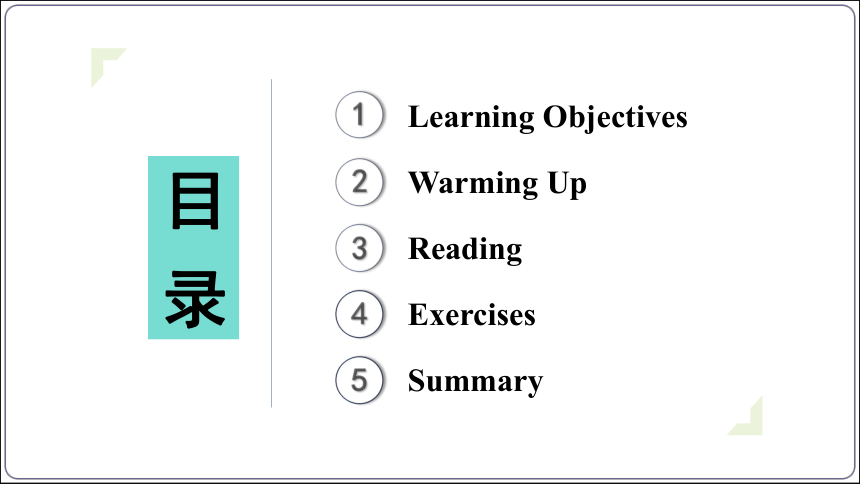
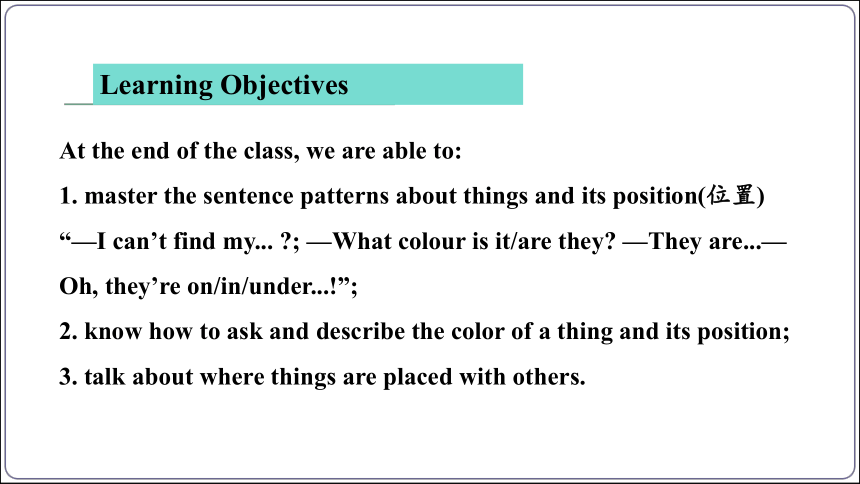
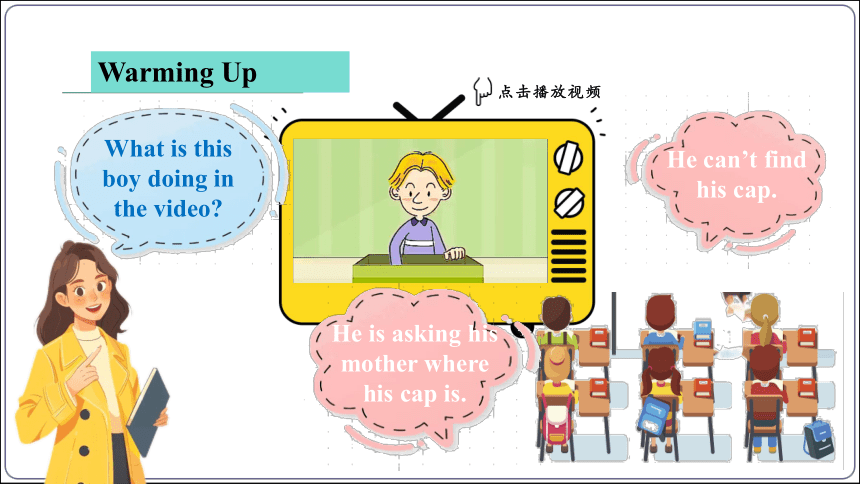
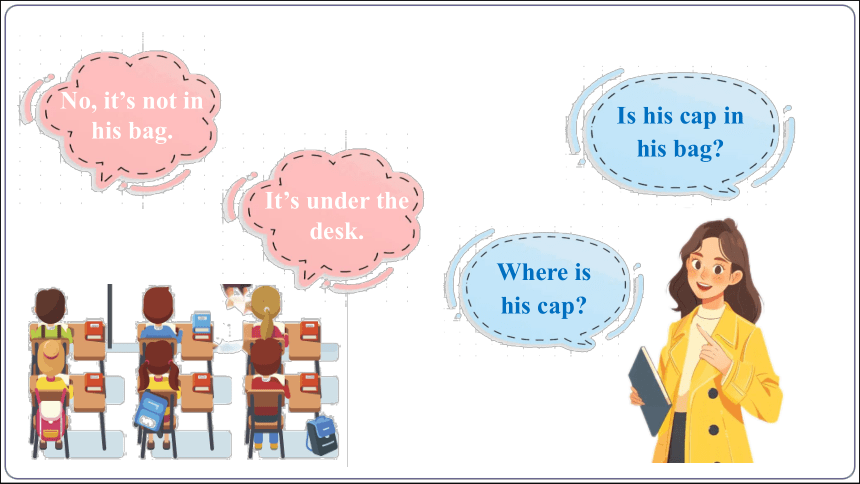
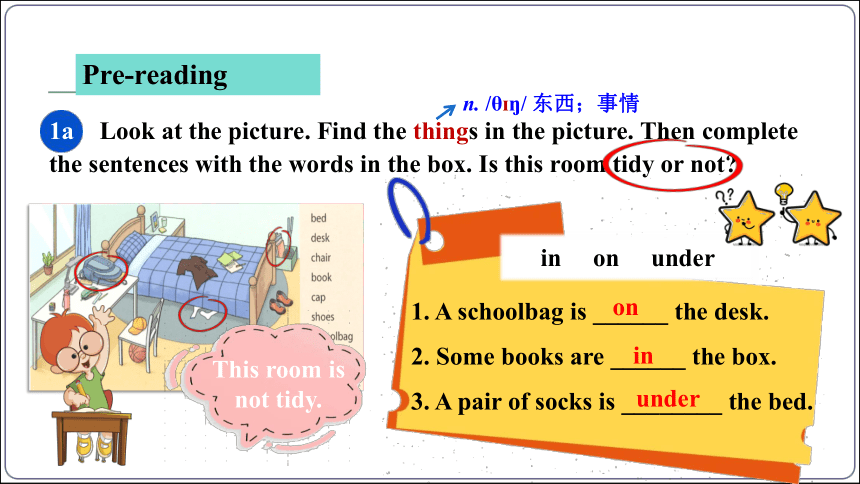
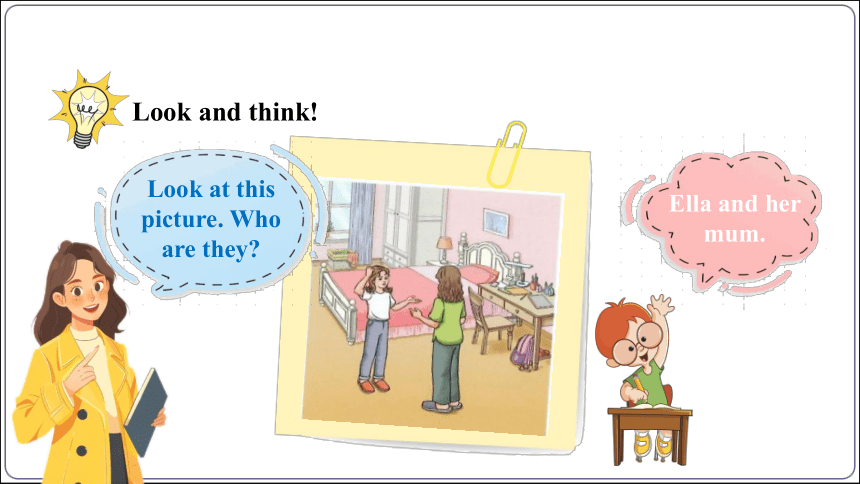
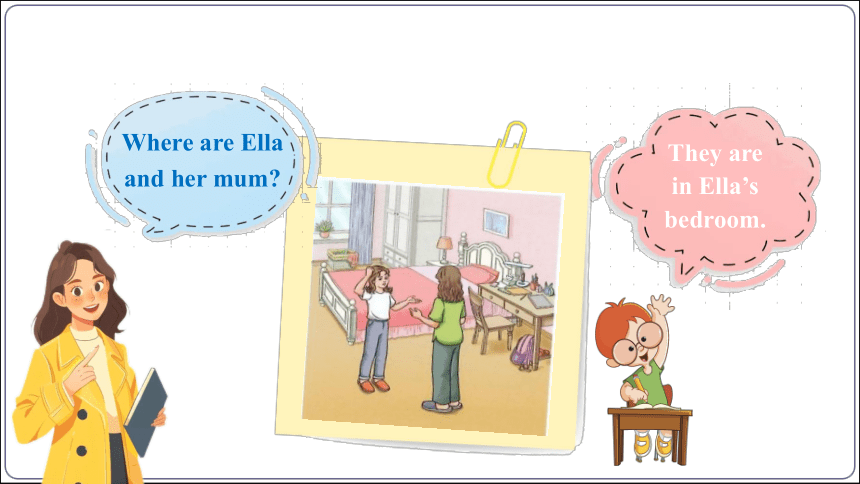
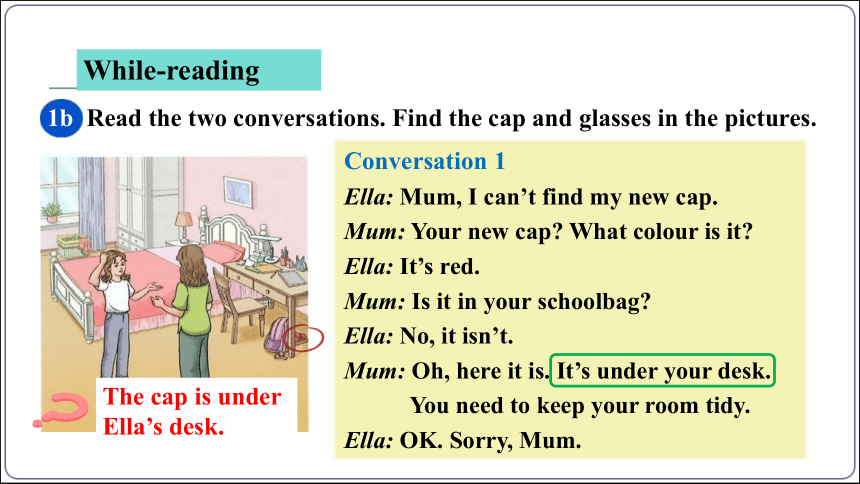
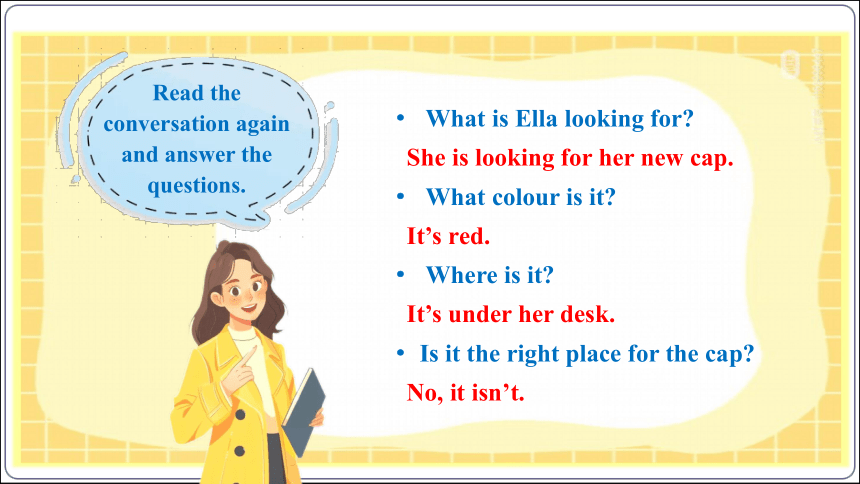

文档简介
(共37张PPT)
人教新版 七上 英语
同步课件
人教新版七上英语情境课堂教学课件(内嵌音视频)
Starter Unit 2 Keep Tidy!
Section B Where do you put your things
目 录
Warming Up
2
Reading
3
Exercises
4
Learning Objectives
1
Summary
5
At the end of the class, we are able to:
1. master the sentence patterns about things and its position(位置) “—I can’t find my... ; —What colour is it/are they —They are...—Oh, they’re on/in/under...!”;
2. know how to ask and describe the color of a thing and its position;
3. talk about where things are placed with others.
Learning Objectives
Warming Up
What is this boy doing in the video
He can’t find his cap.
He is asking his mother where his cap is.
点击播放视频
Is his cap in his bag
Where is his cap
No, it’s not in his bag.
It’s under the desk.
1a Look at the picture. Find the things in the picture. Then complete the sentences with the words in the box. Is this room tidy or not
1. A schoolbag is ______ the desk.
2. Some books are ______ the box.
3. A pair of socks is ________ the bed.
in on under
on
in
under
n. /θ / 东西;事情
Pre-reading
This room is not tidy.
Look and think!
Look at this picture. Who are they
Ella and her mum.
They are
in Ella’s bedroom.
Where are Ella and her mum
1b Read the two conversations. Find the cap and glasses in the pictures.
Conversation 1
Ella: Mum, I can’t find my new cap.
Mum: Your new cap What colour is it
Ella: It’s red.
Mum: Is it in your schoolbag
Ella: No, it isn’t.
Mum: Oh, here it is. It’s under your desk.
You need to keep your room tidy.
Ella: OK. Sorry, Mum.
While-reading
The cap is under Ella’s desk.
· What is Ella looking for
She is looking for her new cap.
· What colour is it
It’s red.
· Where is it
It’s under her desk.
· Is it the right place for the cap
No, it isn’t.
Read the conversation again and answer the questions.
Who can you see in the picture
Emma and her dad.
Look and think!
Look at their faces. Guess. Who can’t find something
Emma’s dad.
Conversation 2
Dad: I can’t find my new glasses. Do you
see them, Emma
Emma: What colour are they, Dad
Dad: They’re brown.
Emma: No, I don’t see them… Oh, wait a
minute. Now I see them! Dad,
they’re on your head!
Dad: Oh, thank you, Emma!
Emma: You’re welcome.
The glasses are on Emma’s dad’s head.
Read the conversation again and answer the questions.
· What can’t Emma’s dad find
His new glasses.
· What colour are they
They’re brown.
· Where are they
They’re on his head.
· Are you a tidy person or an untidy person
· Why should you keep your room tidy
· How do you keep your room tidy
Deep thinking
Here are some questions for you:
Idioms about Habits(关于习惯的习语)
Good habits start at a young age, so it is not surprising that there are many idioms about having good habits. “Old habits die hard” emphasizes(强调) the difficulty of changing habits that we have had for many years. Similarly, we use “creature of habit” to discuss a person who does something naturally, without thinking, out of habit.
Culture Note
Culture Note
Terms of Affection(表达感情的术语)
Although fathers are often referred to as “dad”(e.g. his dad, my dad, your dad), there are many other English terms of affection such as “pops” and “daddy” (usually by younger children). Mothers are sometimes referred to as “mum”, “mummy”, or “mama”.
1c Read the conversations in 1b again and choose the correct answers.
1. Ella’s cap is _____.
A. black
B. red
C. yellow
2. Ella’s cap is _____.
A. in her schoolbag
B. under her desk
C. on her chair
3. Emma’s dad has a pair of new glasses, and they are ____.
A. brown
B. green
C. blue
4. The glasses are on her dad’s ____.
A. desk
B. head
C. nose
1d Write about your things.
My schoolbag is red. It is under my chair.
My trousers are brown. They are on my bed.
1. My _______ is _______. It is ___________.
2. My _______ are _____________. They are ________________.
3. _______________________________________.
4. ____________________________________.
Post-reading
cap
red
on my desk
shoes
blue and white
under my bed
My socks are white. They are on my bed
My bottle is orange. It is in my schoolbag
Language Points
1. A schoolbag is ________ the desk.
2. Some books are ________ the box.
3. A pair of socks is ________ the bed.
on
in
under
pair /pe (r)/ n. 一双;一对。
a pair of shoes/gloves/earrings
通常是指彼此不能分开的两件东西构成的一个物品。
a pair of用法
Point 1
Conversation 1
Ella: Mum, I can’t find my new cap.
Mum: Your new cap What colour is it
Ella: It’s red.
Mum: Is it in your schoolbag
Ella: No, it isn’t.
Mum: Oh, here it is. It’s under your desk. You need to keep your room tidy.
Ella: OK. Sorry, Mum.
v. & n. /ni d/ 需要
Here it is.为倒装句,正常语序为 “It is here.”
Here it is.倒装句
Point 2
need /ni d/ v. 需要;必需
keep /ki p/ v. (使)保持,处于
need及keep用法
Point 3
Conversation 2
Dad: I can’t find my new glasses. Do you see them, Emma
Emma: What colour are they, Dad
Dad: They’re brown.
Emma: No, I don’t see them… Oh, wait a minute. Now I see them! Dad, they’re on your head!
Dad: Oh, thank you, Emma!
Emma: You’re welcome.
wait a minute
等一下;且慢
Point 4
You’re welcome.
别客气;不用谢。
Point 5
Click to do exercise!
1. A pair of socks is under the bed.
pair /pe (r)/ n. 一双;一对。通常是指彼此不能分开的两件东西构成的一个物品。
①常见搭配:a pair of +可数名词复数形式,意为“一双,一对,一副”
鲍勃买了一双鞋。
Bob bought ______ ______ ______ ______.
②若要表达超过一双的量时,则用“数词+pairs of +可数名词复数形式”
鲍勃买了两双鞋。
Bob bought ______ ______ ______ ______.
a pair of shoes
two pairs of shoes
③in pairs,意为“成对的;成双的”
学生两人一组进行角色扮演。
Students work _______ _______ to role-play.
注意:a pair of 做主语时,谓语要用单数。pairs of做主语时,谓语则要用复数。(主语和谓语在人称、数、时态上相一致)
当修饰trousers,shoes,boots等时,不能用one,ones代替,而要用pair或pairs代替。
这双靴子是红色的。
_______ _______ _______ boots _______ red.
这几双鞋很漂亮。
_______ _______ _______ shoes _______ nice.
in pairs
This pair of is
These pairs of are
返回
2. Oh, here it is.
Here it is.为倒装句,正常语序为 “It is here.”
Here + 谓语 + 主语(名词/名词短语)表示“这里有/这是……”
谓语动词的单复数形式取决于后面名词(短语)的数。
这儿有你的尺子。
Here ______ your _______.
这儿有几本你的书。
Here ______ your _______.
is ruler
are books
返回
3. You need to keep your room clean.
(1)need v. 需要;必需 need-needed-needed
1)需要(实义动词,有人称和数的变化)
①need (sb) to do sth 需要(某人)做某事
他得赢下这场比赛以免被淘汰出局。
He _______ _______ _______ this game to stay in the match.
needs to win
②sth need(s) doing = sth need(s) to be done 某事需要被做
这件衬衣该洗了。
This shirt needs washing.
= This shirt _______ _______ _______ _______.
2)需要(情态动词,无人称和数的变化),通常用于否定句或疑问句中,后接动词原形。
needs to be washed
以must开头的一般疑问句的否定回答通常用needn’t,相当于don’t have to
我现在需要回家吗
—Need I come back home now
不,你不必。
—__________________.
No, you needn’t
(2)keep v. (使)保持,处于 keep-kept-kept
①keep+(sth)+adj. (使)(某物)保持/处于
②keep sb/sth doing sth 让某人/某物一直做某事
③keep (on) doing sth 继续做某事,重复做某事
④keep sb/sth (from) doing 阻止某人做某事
保持健康对每个人都很重要。
________ ________ is important for everyone.
让别人一直等待是不礼貌的。
It’s not polite to ________ ________ ________.
Keeping healthy
keep others waiting
爱丽丝重复听英语歌曲来理解它们。
Alice ________ ________ _________ to the English songs to understand them.
在体育课上,我们应该尽量远离危险。
We should try to ________ ________ ________ ________ in PE class.
keeps on listening
keep ourselves from danger
返回
1.(2025安徽改编)—妈妈,你能告诉我为什么我们需要每周去看望祖父母吗?
—他们会很高兴见到我们的。
—Mum, could you tell me why we _______ _______visit my grandparents every week
—They will be happy to see us.
2. —大卫,我可以用一下你的笔记本吗?
—哦,是的。给你!
—David, can I use your notebook
—Oh, yes. _______ _______ _______.
完成句子。
Exercises
need to
Here it is
3. —我现在需要完成作业吗?
—不,你不必。
—Need I do my homework now
—______, ______ _______ .
4. 请保持房间干净。
Please ______ ______ ______ ______.
5. 这些鸟成双成对地飞。
These birds fly ______ ______.
6. 这两双袜子是黑色的。
These ______ ______ ______ ______ ______ black.
No you needn’t
keep the room clean
in pairs
two pairs of socks are
Summary
1. Topic: Ask and describe the color of a thing and talk about its position.
2. Words and expressions: thing, need, You’re welcome.
3. Key sentences:
①—Is it in your schoolbag
—No, it isn’t.
②—Oh, thank you, Emma!
—You’re welcome.
③You need to keep your room tidy.
Thanks!
https://www.21cnjy.com/recruitment/home/fine
人教新版 七上 英语
同步课件
人教新版七上英语情境课堂教学课件(内嵌音视频)
Starter Unit 2 Keep Tidy!
Section B Where do you put your things
目 录
Warming Up
2
Reading
3
Exercises
4
Learning Objectives
1
Summary
5
At the end of the class, we are able to:
1. master the sentence patterns about things and its position(位置) “—I can’t find my... ; —What colour is it/are they —They are...—Oh, they’re on/in/under...!”;
2. know how to ask and describe the color of a thing and its position;
3. talk about where things are placed with others.
Learning Objectives
Warming Up
What is this boy doing in the video
He can’t find his cap.
He is asking his mother where his cap is.
点击播放视频
Is his cap in his bag
Where is his cap
No, it’s not in his bag.
It’s under the desk.
1a Look at the picture. Find the things in the picture. Then complete the sentences with the words in the box. Is this room tidy or not
1. A schoolbag is ______ the desk.
2. Some books are ______ the box.
3. A pair of socks is ________ the bed.
in on under
on
in
under
n. /θ / 东西;事情
Pre-reading
This room is not tidy.
Look and think!
Look at this picture. Who are they
Ella and her mum.
They are
in Ella’s bedroom.
Where are Ella and her mum
1b Read the two conversations. Find the cap and glasses in the pictures.
Conversation 1
Ella: Mum, I can’t find my new cap.
Mum: Your new cap What colour is it
Ella: It’s red.
Mum: Is it in your schoolbag
Ella: No, it isn’t.
Mum: Oh, here it is. It’s under your desk.
You need to keep your room tidy.
Ella: OK. Sorry, Mum.
While-reading
The cap is under Ella’s desk.
· What is Ella looking for
She is looking for her new cap.
· What colour is it
It’s red.
· Where is it
It’s under her desk.
· Is it the right place for the cap
No, it isn’t.
Read the conversation again and answer the questions.
Who can you see in the picture
Emma and her dad.
Look and think!
Look at their faces. Guess. Who can’t find something
Emma’s dad.
Conversation 2
Dad: I can’t find my new glasses. Do you
see them, Emma
Emma: What colour are they, Dad
Dad: They’re brown.
Emma: No, I don’t see them… Oh, wait a
minute. Now I see them! Dad,
they’re on your head!
Dad: Oh, thank you, Emma!
Emma: You’re welcome.
The glasses are on Emma’s dad’s head.
Read the conversation again and answer the questions.
· What can’t Emma’s dad find
His new glasses.
· What colour are they
They’re brown.
· Where are they
They’re on his head.
· Are you a tidy person or an untidy person
· Why should you keep your room tidy
· How do you keep your room tidy
Deep thinking
Here are some questions for you:
Idioms about Habits(关于习惯的习语)
Good habits start at a young age, so it is not surprising that there are many idioms about having good habits. “Old habits die hard” emphasizes(强调) the difficulty of changing habits that we have had for many years. Similarly, we use “creature of habit” to discuss a person who does something naturally, without thinking, out of habit.
Culture Note
Culture Note
Terms of Affection(表达感情的术语)
Although fathers are often referred to as “dad”(e.g. his dad, my dad, your dad), there are many other English terms of affection such as “pops” and “daddy” (usually by younger children). Mothers are sometimes referred to as “mum”, “mummy”, or “mama”.
1c Read the conversations in 1b again and choose the correct answers.
1. Ella’s cap is _____.
A. black
B. red
C. yellow
2. Ella’s cap is _____.
A. in her schoolbag
B. under her desk
C. on her chair
3. Emma’s dad has a pair of new glasses, and they are ____.
A. brown
B. green
C. blue
4. The glasses are on her dad’s ____.
A. desk
B. head
C. nose
1d Write about your things.
My schoolbag is red. It is under my chair.
My trousers are brown. They are on my bed.
1. My _______ is _______. It is ___________.
2. My _______ are _____________. They are ________________.
3. _______________________________________.
4. ____________________________________.
Post-reading
cap
red
on my desk
shoes
blue and white
under my bed
My socks are white. They are on my bed
My bottle is orange. It is in my schoolbag
Language Points
1. A schoolbag is ________ the desk.
2. Some books are ________ the box.
3. A pair of socks is ________ the bed.
on
in
under
pair /pe (r)/ n. 一双;一对。
a pair of shoes/gloves/earrings
通常是指彼此不能分开的两件东西构成的一个物品。
a pair of用法
Point 1
Conversation 1
Ella: Mum, I can’t find my new cap.
Mum: Your new cap What colour is it
Ella: It’s red.
Mum: Is it in your schoolbag
Ella: No, it isn’t.
Mum: Oh, here it is. It’s under your desk. You need to keep your room tidy.
Ella: OK. Sorry, Mum.
v. & n. /ni d/ 需要
Here it is.为倒装句,正常语序为 “It is here.”
Here it is.倒装句
Point 2
need /ni d/ v. 需要;必需
keep /ki p/ v. (使)保持,处于
need及keep用法
Point 3
Conversation 2
Dad: I can’t find my new glasses. Do you see them, Emma
Emma: What colour are they, Dad
Dad: They’re brown.
Emma: No, I don’t see them… Oh, wait a minute. Now I see them! Dad, they’re on your head!
Dad: Oh, thank you, Emma!
Emma: You’re welcome.
wait a minute
等一下;且慢
Point 4
You’re welcome.
别客气;不用谢。
Point 5
Click to do exercise!
1. A pair of socks is under the bed.
pair /pe (r)/ n. 一双;一对。通常是指彼此不能分开的两件东西构成的一个物品。
①常见搭配:a pair of +可数名词复数形式,意为“一双,一对,一副”
鲍勃买了一双鞋。
Bob bought ______ ______ ______ ______.
②若要表达超过一双的量时,则用“数词+pairs of +可数名词复数形式”
鲍勃买了两双鞋。
Bob bought ______ ______ ______ ______.
a pair of shoes
two pairs of shoes
③in pairs,意为“成对的;成双的”
学生两人一组进行角色扮演。
Students work _______ _______ to role-play.
注意:a pair of 做主语时,谓语要用单数。pairs of做主语时,谓语则要用复数。(主语和谓语在人称、数、时态上相一致)
当修饰trousers,shoes,boots等时,不能用one,ones代替,而要用pair或pairs代替。
这双靴子是红色的。
_______ _______ _______ boots _______ red.
这几双鞋很漂亮。
_______ _______ _______ shoes _______ nice.
in pairs
This pair of is
These pairs of are
返回
2. Oh, here it is.
Here it is.为倒装句,正常语序为 “It is here.”
Here + 谓语 + 主语(名词/名词短语)表示“这里有/这是……”
谓语动词的单复数形式取决于后面名词(短语)的数。
这儿有你的尺子。
Here ______ your _______.
这儿有几本你的书。
Here ______ your _______.
is ruler
are books
返回
3. You need to keep your room clean.
(1)need v. 需要;必需 need-needed-needed
1)需要(实义动词,有人称和数的变化)
①need (sb) to do sth 需要(某人)做某事
他得赢下这场比赛以免被淘汰出局。
He _______ _______ _______ this game to stay in the match.
needs to win
②sth need(s) doing = sth need(s) to be done 某事需要被做
这件衬衣该洗了。
This shirt needs washing.
= This shirt _______ _______ _______ _______.
2)需要(情态动词,无人称和数的变化),通常用于否定句或疑问句中,后接动词原形。
needs to be washed
以must开头的一般疑问句的否定回答通常用needn’t,相当于don’t have to
我现在需要回家吗
—Need I come back home now
不,你不必。
—__________________.
No, you needn’t
(2)keep v. (使)保持,处于 keep-kept-kept
①keep+(sth)+adj. (使)(某物)保持/处于
②keep sb/sth doing sth 让某人/某物一直做某事
③keep (on) doing sth 继续做某事,重复做某事
④keep sb/sth (from) doing 阻止某人做某事
保持健康对每个人都很重要。
________ ________ is important for everyone.
让别人一直等待是不礼貌的。
It’s not polite to ________ ________ ________.
Keeping healthy
keep others waiting
爱丽丝重复听英语歌曲来理解它们。
Alice ________ ________ _________ to the English songs to understand them.
在体育课上,我们应该尽量远离危险。
We should try to ________ ________ ________ ________ in PE class.
keeps on listening
keep ourselves from danger
返回
1.(2025安徽改编)—妈妈,你能告诉我为什么我们需要每周去看望祖父母吗?
—他们会很高兴见到我们的。
—Mum, could you tell me why we _______ _______visit my grandparents every week
—They will be happy to see us.
2. —大卫,我可以用一下你的笔记本吗?
—哦,是的。给你!
—David, can I use your notebook
—Oh, yes. _______ _______ _______.
完成句子。
Exercises
need to
Here it is
3. —我现在需要完成作业吗?
—不,你不必。
—Need I do my homework now
—______, ______ _______ .
4. 请保持房间干净。
Please ______ ______ ______ ______.
5. 这些鸟成双成对地飞。
These birds fly ______ ______.
6. 这两双袜子是黑色的。
These ______ ______ ______ ______ ______ black.
No you needn’t
keep the room clean
in pairs
two pairs of socks are
Summary
1. Topic: Ask and describe the color of a thing and talk about its position.
2. Words and expressions: thing, need, You’re welcome.
3. Key sentences:
①—Is it in your schoolbag
—No, it isn’t.
②—Oh, thank you, Emma!
—You’re welcome.
③You need to keep your room tidy.
Thanks!
https://www.21cnjy.com/recruitment/home/fine
同课章节目录
